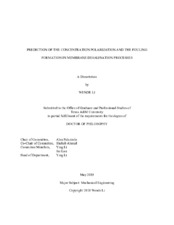| dc.contributor.advisor | Palazzolo, Alan | |
| dc.contributor.advisor | Ahmed, Shehab | |
| dc.creator | Li, Wende | |
| dc.date.accessioned | 2019-10-16T20:44:01Z | |
| dc.date.available | 2021-05-01T12:33:52Z | |
| dc.date.created | 2019-05 | |
| dc.date.issued | 2019-03-19 | |
| dc.date.submitted | May 2019 | |
| dc.identifier.uri | https://hdl.handle.net/1969.1/185030 | |
| dc.description.abstract | Membrane desalination provides fresh water product beyond the hydrologic cycle, and is promising especially for coastal regions with a freshwater shortage. Membrane lifetime and permeate flux are affected by the concentration polarization (CP) phenomenon and membrane surface fouling. A numerical simulation model based on the lattice Boltzmann method (LBM) is developed and an effective flux boundary scheme is proposed in this study to predict CP and inorganic fouling growth. Results of the CP and permeate flux prediction are compared with published results in a complete rejection condition. When the membrane rejection rate is considered, prediction results show that a higher membrane rejection rate results in not only better product water quality but also higher CP and lower permeate flux. CP and permeate prediction results in a spacer filled desalination channel indicate that there is a higher fouling potential immediately behind the spacer filaments. Coupling of the CP prediction model with gypsum growth kinetics provides an approach to study inorganic fouling growth on the membrane surface at a single crystal level. The axially asymmetric growth of the gypsum crystal shown in the fouling growth result could be explained by the concentration field result that the salt concentration decreases from the crystal frontal flow-stagnation edge to the rear of the crystal. Predicted equivalent radius and accumulated mass of the growing gypsum crystal agree with analytical results and published test data.
A vibration assisted desalination process is proposed and experimentally realized using a periodically oscillating desalination cell. Test data shows that CP near membrane surface can be reduced in the vibration assisted desalination. A slower flux decline can be observed in the vibration assisted desalination with a larger vibration velocity. Experimental observations validate that the proposed vibration assisted desalination process helps enhance the permeate flux and mitigate the formation of inorganic fouling on the RO membrane surface. A novel desalination centrifuge is designed in this study to reduce desalination hardware cost and mitigate membrane fouling. An estimation of energy consumption of the designed centrifuge shows that under certain conditions, the power usage by the desalination centrifuge is less than the industrial average. | en |
| dc.format.mimetype | application/pdf | |
| dc.language.iso | en | |
| dc.subject | Membrane desalination | en |
| dc.subject | Concentration polarization | en |
| dc.subject | Membrane fouling | en |
| dc.subject | Lattice Boltzmann method | en |
| dc.subject | | en |
| dc.title | Prediction of the Concentration Polarization and the Fouling Formation in Membrane Desalination Processes | en |
| dc.type | Thesis | en |
| thesis.degree.department | Mechanical Engineering | en |
| thesis.degree.discipline | Mechanical Engineering | en |
| thesis.degree.grantor | Texas A & M University | en |
| thesis.degree.name | Doctor of Philosophy | en |
| thesis.degree.level | Doctoral | en |
| dc.contributor.committeeMember | Li, Ying | |
| dc.contributor.committeeMember | Lau, Sai | |
| dc.type.material | text | en |
| dc.date.updated | 2019-10-16T20:44:01Z | |
| local.embargo.terms | 2021-05-01 | |
| local.etdauthor.orcid | 0000-0001-7800-7518 | |


